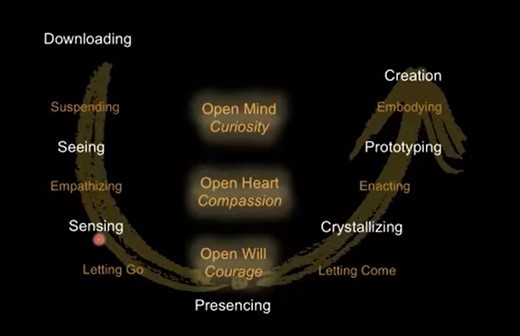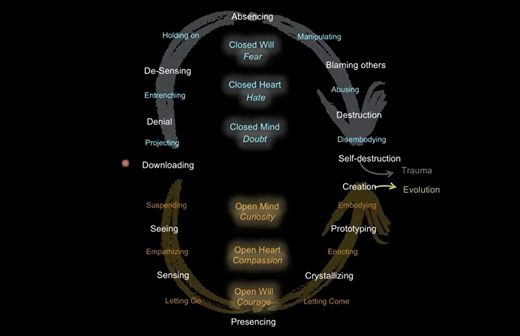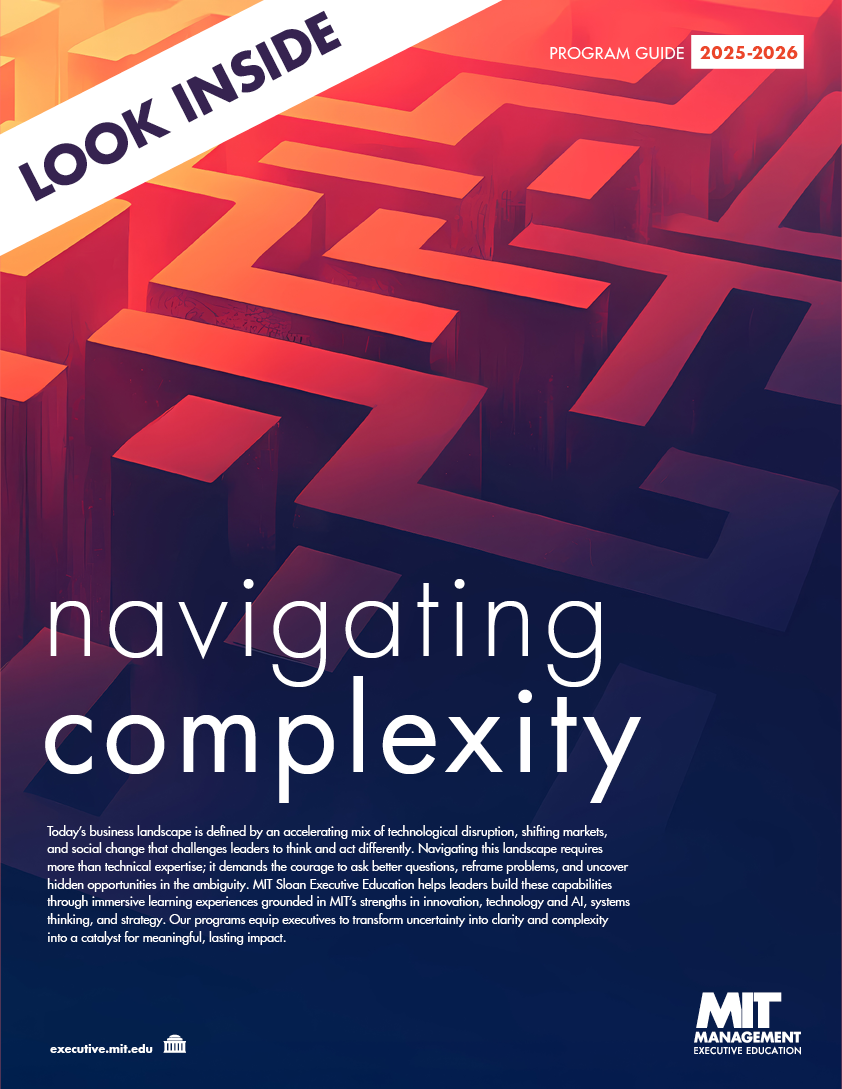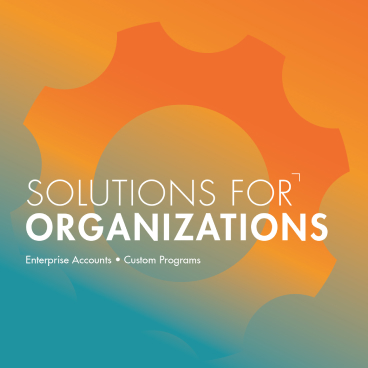We ended our webinar series of 2020 with MIT Sloan Senior Lecturer Otto Scharmer – Innovating in the Face of Disruption: How to Lead from the Emerging Future. (A fitting theme as many of us take this time to reflect on the past year and think about the new one). This webinar introduced participants to the foundations of awareness-based systems thinking and how to see situations from a whole systems perspective, and also discussed the importance of deep listening.
This past year has probably been the best teacher when it comes to understanding Systems Thinking. We have become aware of not only of how interconnected we are, but have also been forced to confront everything that we already knew was “broken.” For better or worse, 2020 has taught us how to respond to disruption – which is all about connection. When you live in a state of disruption, it allows you to connect with what is truly essential for you on a deeper level and allows you to let go of the non-essential. But how do you get from the current state of being – to the lesser known future? It takes a journey – both outward and inward – and that’s where the Systems Thinking model comes into play.

All systems thinking starts with distinguishing the symptoms (above the surface) from the root issues (below the surface). A leader needs to do more than just react against symptoms, they seek to understand the root issues in order to drive awareness-based systems change.
Otto summarizes this with four principles:
You can’t understand a system unless you change it.
You can’t change a system unless you transform consciousness/mindset. Meaning, you need to address all symptoms and root issues.
You can’t transform consciousness unless you make a system see and sense itself. Think of this as having a mentor when you’ve gone through a period of profound change. You need someone to listen to you and mirror back what you’re sharing.
You can’t transform a system unless you sense and actualize the emerging future. The essence of leadership is stepping from one territory into another. It’s your responsibility to learn from the past and connect it emerging future possibilities.
Following these four principles allow people to have a shift in perspective – the single most important result. It’s a shift of debate to dialog, a conversation to help us reflect on our own assumptions and contributions within the system. This self-awareness of your “inner place” from which you operate, is an important part of leadership.
THE U CURVE
Otto also introduced the U-Curve as a roadmap for leaders looking to transition from the unknown to an innovative future.

You need an open mind (curiosity and observation), an open heart (compassion, seeing things from a different stakeholder’s POV), and an open will (courage to let go of the old and welcome the new).
Unfortunately, what’s been happening more often, and hindering efforts, is the complete opposite – an inverted U.

So how do we overcome this? Humility as a leader is key. Listen with humility and let the data talk to you. Bring large diverse stakeholder groups together and help them move to co-creative relationships. Ask yourself: Are you available for your people? Creating safe spaces? Actively listening? Or, are you pulling out and disappearing and trying to figure things out on your own?
One thing we’ve learned this year is never let a crisis go to waste. This pandemic has functioned as an innovation accelerator for many organizations. People are amazed with what can get done and how quickly - from vaccine development to moving courses online. However, as we’ve seen, the same crisis yields vastly different results for many organizations – and much of that comes down to leadership through the U-Curve.
Otto covered a lot of ground during his Deep Dive webinar, but those 60 minutes flew by and there were still many wonderful questions from participants we couldn’t address in this extended time frame. We collected them and curated their answers during a follow-up interview with Otto below.
How do you practice what you preach as a leader when current situations unfold everyday with uncertainty? How do you qualify oneself – there’s humility but there’s also not wanting to be perceived as weak or incompetent. How do you reconcile the two so your team doesn’t feel even more lost?
I would say two things.
One: Listening doesn’t mean you’re weak. Reaching out to another person or another perspective doesn’t mean you’re weak. It just a means to relate.
Two: Yes, in leadership there are moments you need to operate in your armor, so to speak, to defend positions and put your foot down and engage in arguments. But, there are other moments where what’s required of you as a leader is more than just showing up in your armor. What’s required of you is to move out of that armor and become visible as a human being. As a leader you’re also a human being and sometimes you need to show up as a human being, particularly to your team and key stakeholder relationships.
The term to describe that is “vulnerability.” This is a 21st century leadership capacity because it allows you to connect on a different level. And as I discussed during the webinar – how do we reach across the aisle and connect with people in the hostile bubble, so to speak? Well, it’s not by rational argument. That’s not going to work - we know that. You need to relate to these individuals first. When you have a relationship, then you can share perspectives with each other more easily. Being receptive to what happens around you is a key function of leadership, but that doesn’t mean you’re weak.
The concept we should be striving for in leadership is robust vulnerability. Meaning, yes, there is a moment where I open up and show up as a human being and can relate – but I’m still holding things together and not just collapsing under the emotional weight of everything. I can then take the relationship into next stage – whether that’s following the U curve or some other process.
So in 21st century environment of disruption, I would say robust vulnerability is a key dimension on how you connect. And the problem with leading innovation in an age of disruption is not that we don’t have enough ideas – that’s never the problem. The problem is we don’t have a shared map – we don’t have a shared body of resonance that if in place allows me as a leader to activate collective creativity on my team. If I’m the only one having the brilliant idea – I can’t connect to all the stakeholders around who I need to join in the action. I’m not effective.
You had mentioned during the webinar reaching across the aisle and making arguments - not just with facts – but also utilizing empathy. A lot of concerns came up with regards to working with people who are stuck (sometimes seemingly intently and happily so) in the Inverted U. How do you reconcile that and find that common ground to proceed together?
So that definitely is a profound question out there with which we’re all dealing. I’m not pretending that I have it all figured out, but I would say this is a situation many of us have faced. And in these situations, there are a few options.
If you have that relationship with someone, just trying to “outsmart” the other party with facts or trying to publicly shame them, is not a very successful strategy. So one of the options you have is to disengage. Simply get out of the way – give each side its space. You need to ask yourself “Do I really need to engage in this relationship?” And if you don’t, that’s one solution.
But let’s say you can’t disengage because they’re a stakeholder you need. Public shaming didn’t work. Presenting them with facts didn’t work. Then the only option left is to engage in listening.
With regards to listening, what I mean is we need to establish a relationship based on respect. First, it requires you to suspend your own judgement. Not because it’s a necessarily bad or invalid judgment – but because if you want to build a relationship, and you lead with your judgement, nothing is going to change.
Second, suspend the voice of cynicism, because that’s also distancing you from the other person. If you operate on cynicism you amplify a relationship that’s not healthy, that’s toxic.
Third, suspend the voice of fear, which we are often are more quick to see in others, but it also seeps into our own way of operating.
By suspending these three voices – judgement, cynicism, and fear – we can build those relationships. Then we need to try to understand the narrative (again, without judgement). This is naturally easy for us as humans, because if we get into a person’s story it’s easy to follow and understand how it evolves. It’s quite easy for us to be in the shoes of someone else with very different views and values. Before we can connect with someone who is very different from us, we have to create a place within ourselves – within own heart - for that other person. This is the inner work we need to do before we can have a very different relationship with that other person.
I’m actually practicing this with my students at MIT. I learned this from my mentor Ed Schein – he invented a practice called Empathy Walk and I do this the first week of my classes. I have students team up with a person that’s totally different from them – it’s up to them how they define that. Then they spend a couple of hours in the life of that person, essentially being a guest in that person’s life. This is just one small example, but basically it’s prompting people to get out of their own bubble. The impact of this little practice – of honing deeper listening skills and building relationships – is very profound.
So yes, listening can be developed, relationships can be developed – and yes it is challenging working on those three voices of judgement, cynicism and fear. But we ultimately need to create a place for that person in our heart first.
Sounds like we’re using a little of that humility you talked about earlier as well.
Exactly!
At what point do you come to the conclusion that the group you're trying to take through this journey of the U aren't prepared or ready and that it’s a waste of time? (Assuming that’s ever the case). At that point, what should you do? Not necessarily from a personal perspective, but from a professional and organizational standpoints. Do you implement the same techniques, or are they different on an organizational level?
Yes, it is different on an organizational level and scale regarding how you create these environments. But in terms of leadership philosophy, it’s not really that different. It’s the same deeper principles at work. For me, the simple response is something I learned during process consultation and from my mentor Ed Schein here at MIT. If in doubt and don’t know what to do – ask the client.
Approach questions by creating more awareness and transparency. If you don’t know, lean into the collective and activate the knowledge that’s there by just asking that question and mirroring back.
Create conditions for your leadership team to share and go through the process, really co-sensing together to understand what the current reality looks like from all angles. You connect with a deeper sense of resonance – it’s not just about being analytical, it’s about understanding how everything we’ve done up to this point relates to our own unfolding journey and who we want to be tomorrow. At the bottom of U process, what you always try to do is bring in who they are today and who they could be tomorrow. You begin to activate people’s highest future possibilities – or at least you create a space for that.
And then you learn by doing – co-creativity.
Lastly, is there an area of the journey which by experience you have found is the most difficult for leaders to apply? Any tips of how to get unstuck and move to the next phase.
If I had to summarize the three key things I’m doing as a leader and a facilitator, they’d be the following
One: Staying With - Often the problem is we jump to a conclusion too early. In a place of sense-making, you’re figuring out “Should we do option A or B?” Staying With means staying – as a group – in in that decision process just a little while longer – holding the space for the group to determine what the right choice is. It’s not just you as a leader making the decision.
Two: Being With – This means understanding the larger collective story that everyone is a part of through ecosystem of the organization. (The bottom of the U curve).
Three: Creating With – This involves activating the intelligence of your environment or ecosystem of collaborators.
So these would be the three inner capacities that I’ve noticed are really critical. However, I would also say that just “holding the space” – to co-sense, to create, to understand – is a core capability that’s underappreciated in leadership. By some it may be seen as inaction. Not true. I would say it’s the invisible part of leadership which today matters the most.
Learn more about System Dynamics with one of our courses:
Business Dynamics: MIT's Approach to Diagnosing and Solving Complex Business Problems








